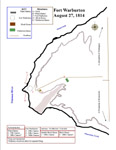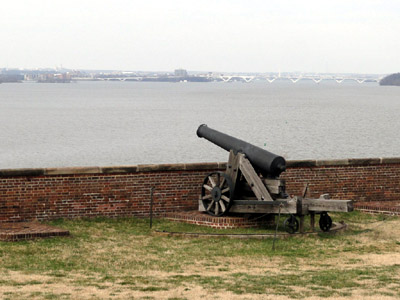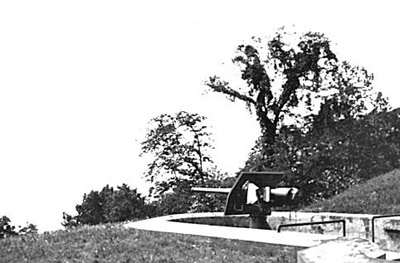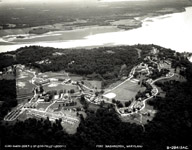 |
Fort Washington
Prince George County, Maryland
|
|
 |
The first Fort Washington (also called Fort Warburton), an earthwork structure that was only about the size of the current Fort Washington's Water Battery (the triangle of earthy stuff at the bottom of the picture above), was built in 1809 at a bend in the Potomac River, where it meets Piscataway Creek. Fort Washington was the only fortification defending the shiny new United States' capital, Washington DC, from riverborne attack, presumably from the wicked British, upon whom the US would declare war on June 1 1812.
For the first two years of the War of 1812, Britain was hampered somewhat by its responsibilities in Europe, what with the whole Napoleon-trying-to-take-over-the-entire-universe thing going on. Once Napoleon (1769-1821) was (temporarily) defeated in 1814, however, Great Britain rolled its Big Red Machine in the direction of the US, fully intending to quash this ridiculous new republic once and for all.
And they did a pretty good initial job with the quashing, defeating the underdeveloped American militia at the Battle of Bladensburg (August 24 1814) in Maryland, which left the road to Washington DC open. The British made the short march to Capitol Hill, where they commenced with their joyous destruction.
|
Three days later, Captain Samuel P. Dyson, who had been the commanding officer of the rather dilapidated Fort Washington for all of ten days, saw a British fleet on the Potomac. He received intelligence that the marauding British army, fresh from torching Washington DC, had turned and was marching in his direction. Though this information was faulty, Dyson had orders to destroy and abandon his position if threatened by an attack by land (there were 56 able-bodied men stationed at Fort Washington, enough to serve perhaps five of the 31 cannon emplaced there and in a blockhouse nearby...but there was nothing oriented towards a landward defense). In the late afternoon of August 27, 1814, the guns were spiked and the fuse to the magazine was lit by the skedaddling Americans. Kerboom went Fort Washington.
|
 |
 Fort Warburton, August 1814 (Click to see full-sized) Fort Warburton, August 1814 (Click to see full-sized) |
|
Predictably horrified at the defenselessness of their now charred capital city, twelve days after Fort Washington's self-destruction congress hired French engineer Pierre L'Enfant (1754-1825), famous as the architect of Washington DC's layout, to design a proper fortification. L'Enfant worked only briefly on the project, completing only the design. Before ground was even broken for the new fort, disagreements over money with congress (L'Enfant had yet to be satisfactorily paid for the work he had done on Washington DC in the early 1790's) caused him to be sacked and replaced with Lieutenant Colonel Walker K. Armistead (1785-1845) of the U.S. Army Corps of Engineers. Armistead's brother, Lieutenant Colonel George Armistead (1780-1818), was the commanding officer of Fort McHenry during the British bombardment that inspired Francis Scott Key (1779-1843)'s "Star Spangled Banner," and his son, Brigadier General Lewis Armistead (1817-1863), died at the Battle of Gettysburg (July 1-3, 1863) leading Pickett's Charge.
|
 A 24-pounder cannon on a "barbette carriage" looks protectively o'er the Potomac A 24-pounder cannon on a "barbette carriage" looks protectively o'er the Potomac |
 |
Despite being the least historically illustrious of the Armisteads, Col. Walker K. did a fine job of finishing up L'Enfant's work, and the imposing new Fort Washington was completed on October 2, 1824. Improvements were instantly deemed necessary, a process that kept the first guns from being emplaced until 1846.
Fort Washington witnessed its only post-War of 1812-carnage on February 28, 1844. US President John Tyler (1790-1862) and a host of dignitaries were on a pleasure cruise along the Potomac in the USS Princeton, the US Navy's first steam-powered frigate, which had just been launched the previous year. While steaming placidly past Fort Washington, one of the ship's revolutionary new guns, being demonstrated for the on-board bigshots, exploded.
|
|
Tyler narrowly escaped death, but Secretary of State Abel P. Upshur (1790-1844) and Secretary of the Navy Thomas Gilmer (1802-1844) were instantly killed, among other high-ranking folks. Also aboard and likely somewhat deafened (but otherwise unharmed) was former First Lady Dolley Madison (1768-1849).
One result of this tragedy was that, for decades thereafter, the US Navy's policy was to fire its guns with only a half-load of gunpowder. This perhaps saved some from the grisly fate of those killed by the explosion on the Princeton, but became an issue during the US Civil War (1861-1865): In the Battle of Hampton Roads (March 8-9, 1862), which pitted the ironclads USS Monitor against the CSS Virginia (Merrimac), the Monitor's 11-inch Dahlgren guns, fired with the standard service charge of powder, proved insufficient to the task of piercing the Virginia's armor. The Virginia, under no such restriction, could have easily sent the Monitor to the bottom of Hampton Roads had it been supplied with armor-piercing shot. Only expecting to slaughter the Union's wooden sailing ships, however, the Virginia only carried regular shell.
One of the issues addressed in the 1840's was the lack of defenses on the back side of Fort Washington. The Caponniere (the little weenie-like thing sticking out of the top of the fort in the top picture), filled and topped with cannon, was designed and built by US Army Engineer Robert E. Lee (1807-1870), who would of course go on to become the foremost example of Southern Gentlemanliness, in addition to commanding the Confederate Army in the US Civil War.
Fort Washington remained the only permanent fortification on the Potomac until the US Civil War, when a number of forts spontaneously popped up in a ring around Washington DC. Battery Rogers and Fort Foote were built a little further up the Potomac to help defend the city from the mighty Confederate fleet that never materialized.
In 1872 Fort Washington's garrison was removed as part of plans for a grand new defense system for DC. A more modern fortification (Battery White) was built at the front tip of the Water Battery, but perhaps because there was no perceived immediate threat, funds for further development were held up, and Fort Washington sat unoccupied for the next 20 years. |
In 1885, US President Grover Cleveland (1837-1908) appointed the Board of Fortifications, headed by Secretary of War William Crowninshield Endicott (1826-1900). No work on the defenses of US shores had been undertaken since the early 1870's, and rapid overseas weapon development, primarily in ships and cannon, had rendered virtually all of the US' harbor defenses obsolete.
As Fort Washington's slice of the $127 million that was set aside for a vast defensive buildup, ground was broken in 1892 for Battery Decatur, a concrete monstrosity that
|
 |
 A rapid-fire gun at Battery James Many circa 1890 A rapid-fire gun at Battery James Many circa 1890 |
|
mounted two ten-inch "disappearing" guns, the flower of 1890's technology.
Also built on the periphery of Fort Washington in what became known as the Endicott Period were Battery James Many, which mounted two three-inch rapid fire guns, intended to keep enemy ships from messing with carefully laid minefields in the Potomac (the minefields were laid out to keep enemy ships within range of the big guns on both sides of the Potomac); Battery Meigs, which housed eight enormous 12-inch mortars, meant to drop concentrated fire onto the thinly-armored decks of enemy ships; and a scattering of six other small batteries, sprinkled lovingly o'er the grounds of Fort Washington, mostly covering Pascataway Creek. These batteries and four more across the Potomac at Fort Hunt made up the US Army's exciting new Potomac Defense Command: Unfortunately, no invincible Spanish Armada ever showed up to put it to the test.
|
 Fort Washington from the air, 1937 (Click to see full-sized) Fort Washington from the air, 1937 (Click to see full-sized) |
 |
Just prior to the First World War (1914-1918), Fort Washington's heavy guns were ripped out, eventually to be sent to Europe to be mounted on railway cars, which was what all the cool kids in Europe were doing with their huge cannon at the time. Fort Washington was downgraded to the slightly less prestigious realm of "harbor defense," and the fort was used as a staging area for troops being sent to France to fight the Hun.
In 1939, the army abandoned Fort Washington once again. A bridge over the Potomac was slated to be built at this location, with Fort Washington to be used as a terminal point. Fortunately for millions of people, the Second World War (1939-1945) broke out, and the army rushed back in to Fort Washington.
|
|
During World War II, Fort Washington, now housing nearly 3,000 men, was used as the US Army's Adjutant General School. In 1946 the fort returned to the Department of the Interior's control.
Today, Fort Washington is an absolutely lovely park, open daily for casual strolls, fishing, picnicking or joyous, frenzied scamperings through the cool dankness that can only be experienced in nearly-200-year-old casemates.
Ten thousand thanks to Ranger Wesley Gant, who not only calmly answered my many frantic questions at the fort and over the phone, but provided me with several of the pictures included on this page.
|
|
|
|
|
|
 |




